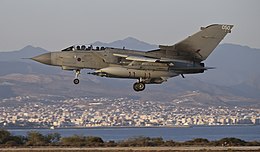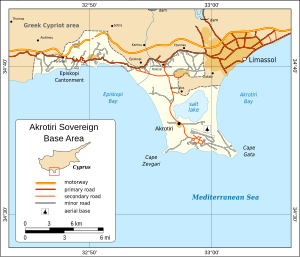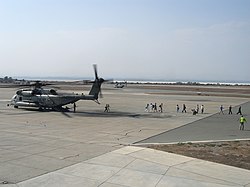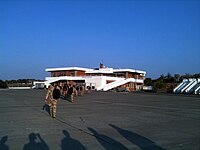Difference between revisions of "RAF Akrotiri"
(Created page with "{{Infobox airport |name=RAF Akrotiri |territory=Akrotiri and Dhekelia |picture=RAF CONDUCTS FIRST AIR STRIKES OF IRAQ MISSION MOD 45158633.jpg |picture caption=RAF Tornado ret...") |
(No difference)
|
Revision as of 22:01, 27 July 2018
| RAF Akrotiri | |
| Code | IATA: AKT, ICAO: LCRA |
|---|---|
| Territory | Akrotiri and Dhekelia |
| Owner | Ministry of Defence |
| Operator | Royal Air Force |
| Location | 34°35’26"N, 32°59’16"E |
| Runway | 9,000 feet (Asphalt) |
| Website | https://www.raf.mod.uk/rafakrotiri/ |
Royal Air Force Akrotiri or more simply RAF Akrotiri (IATA: AKT, ICAO: LCRA) is a large Royal Air Force station within the Western Sovereign Base Area, one of two areas which comprise Akrotiri and Dhekelia, a British Overseas Territory, administered as a Sovereign Base Area.
The station commander has a dual role and is also the officer commanding the Akrotiri or Western Sovereign Base Area, reporting to the commander of British Forces Cyprus who is also the Administrator of the territory.
Contents
History
Foundation
RAF Akrotiri was first constructed in the mid-1950s to relieve pressure on the main RAF station on the island, RAF Nicosia. After the ending of the League of Nations mandate over Palestine in 1948, the only other British territory in the eastern Mediterranean was Cyprus. In the aftermath of the Egyptian repudiation of the Anglo-Egyptian treaty of 1936, British forces also had to be withdrawn from the Suez Canal Zone in Egypt, and in consequence there was an enormous build-up of forces in Cyprus. This period also coincided with the outbreak of the internal security problems, particularly the EOKA campaign of terrorism, in Cyprus, further increasing pressure on the RAF airfields on the island.
Suez Crisis
Even this massive influx from Egypt was not the end. In late 1956, relations between the United Kingdom and Egypt deteriorated to the brink of war, in what was known as the Suez Crisis, which saw a further increase in the strength of RAF forces in Cyprus. Akrotiri was mainly an airfield for fighter, photo reconnaissance and ground attack aircraft. Its regular squadrons of Gloster Meteor night fighters, Canberra photo reconnaissance aircraft and Venom ground attack machines were reinforced by further Canberras and Hawker Hunters from RAF Fighter Command in the United Kingdom. The airfields in Cyprus were so overcrowded that there was a real fear of massive loss of equipment should the Egyptian Air Force decide to attack the island. Fortunately for the RAF, that attack never came. The overcrowding extended beyond Cyprus. Significant RAF units from Bomber Command were deployed to RAF Luqa in Malta, crowding that station as well.
The British and French attack on Egypt began on 5 November 1956. It was a military success, despite interference in the plan which reduced its effectiveness. However, it was a political fiasco, because the United States put considerable pressure on the United Kingdom and France both economically and politically. This quickly forced the Eden government from power. The station's complement quickly returned to normal after the crisis passed, with the reinforcing units that had crowded it during the war returning either to the United Kingdom or to other parts of the Middle East Command.
1960s
After the Suez Crisis, the main emphases of life on the airfield shifted to helping quell the EOKA revolt, and training missions. After the withdrawal from both Egypt and Iraq, and Suez Crisis, it was clear that a command centred on Cyprus could not control units stationed in the Arabian Peninsula, of which there were still many. Consequently, the Middle East Command was split, with that east of Suez being controlled from Aden, and the remainder being renamed the 'Near East Command', controlled from Cyprus. From 1957 to 1969, four squadrons operating the Canberra (No. 6 Squadron, No. 32 Squadron, No. 73 Squadron, and No. 249 Squadron) provided first a conventional and then from November 1961, a nuclear striking capability as part of the Baghdad Pact, later the Central Treaty Organization (CENTO).[1]
Akrotiri, along with Nicosia, assumed a very important status, as virtually the sole means for projecting British airpower into the eastern Mediterranean, outside of aircraft carriers. In 1960, independence was granted to Cyprus, but the RAF maintained both RAF Nicosia and RAF Akrotiri as airfields, controlled by the Near East Air Force. The areas around Akrotiri and around Dhekelia were excluded from the grant of independence and so remained British terrirory, as they remain today. Akrotiri assumed more importance as Nicosia (within the new Republic of Cyprus) was used primarily for civil aviation. After 1966, it was no longer possible to maintain RAF units at Nicosia due to pressures of space, and Akrotiri became the only RAF flying station left on the island.
1970s
In August 1970, detachment "G" of the Central Intelligence Agency arrived at the airfield with Lockheed U-2 reconnaissance aircraft to monitor the Egypt/Israel Suez Canal fighting and cease fire. Permanent monitoring of Middle East Ceasefire was undertaken by the 100th Strategic Reconnaissance Wing after the 1973 Yom Kippur War, known as Operation "Olive Harvest".[2]
Up until 1974 RAF Akrotiri had a balanced force of aircraft assigned to it, including No. 9 Squadron and No. 35 Squadron, both flying Avro Vulcan strategic bombers. The Vulcans provided a bomber force for CENTO, one of the three main anti-Communist mutual defence pacts signed in the early days of the Cold War.[3] However, during that year, Turkish forces invaded Cyprus. Britain then evacuated most of the RAF from Akrotiri as the CENTO treaty had degenerated to the point of uselessness. The two Vulcan squadrons left for stations in the United Kingdom in 1975. What was left at the airfield was the flying unit that is permanently assigned to the station to this day; No. 84 Squadron, a helicopter search and rescue unit. In addition, the role of No. 34 Squadron RAF Regiment was changed from Low level Air Defence to infantry and counter terrorist duties.
In September 1976 the American U-2 operations were turned over to the 9th Strategic Reconnaissance Wing (9th SRW) but the U-2 operation at RAF Akrotiri continued to be called Operating Location (Olive Harvest) OH until September 1980. Thereafter it became Detachment 3 of the 9th SRW, although the name OLIVE HARVEST continues. Two U-2s are stationed at RAF Akrotiri and they are still monitoring the ceasefire agreement between the Egypt and Israel although the present operations in the United States Central Command area requires further missions. U-2s also transit through RAF Akrotiri either on going into the Central Command theatre or returning to California.
1980s
Between April 1983 and September 1984, RAF Boeing Chinooks helicopters deployed to Akrotiri in support of British United Nations Forces in Lebanon.
In the mid-1980s, the US launched retaliatory attacks against Libya after the country's leader, Muammar al-Gaddafi, was implicated in terrorist attacks against US military bases. Although the bombing operations were staged out of bases in Britain, Akrotiri was employed in the role of an alternate in case of emergency, and was used as such by at least one aircraft. This caused a severe upgrade in security around the airfield as Libya threatened to respond against locations used in staging the attacks. The Libyan threat was carried through when an unknown supposed Palestinian group attacked the station on 3 August 1986 with mortars, rocket-propelled grenades and small arms. It was generally assumed that this was commissioned and underwritten by Libya. Three British dependants were wounded although damage was negligible. Security at the station remained high with substantial fortifications constructed along its northern perimeter, until the first Gulf War.
2010s
In July 2006, RAF Akrotiri played a major role as a transit point for personnel evacuations out of Lebanon during the 2006 Lebanon War.
Akrotiri was the location of the main transmitter of the well known numbers station, the 'Lincolnshire Poacher'. Transmissions ceased in 2008.
In March 2011, the station was used as a staging base for support aircraft involved in Operation Ellamy, the British contribution to the NATO-led military intervention in Libya. Tanker support and logistical units were based here to support aerial operations over the country.[4]
In August 2013, six RAF Typhoon aircraft were deployed to Akrotiri to defend the base, following possible military responses to an alleged Syrian government chemical weapons attack. Earlier two Lockheed Tristar air-to-air refuelling aircraft and a Boeing Sentry AEW1 had been deployed to Akrotiri.[5][6]
The station hosted the main hospital for British Forces Cyprus, The Princess Mary's Hospital (TPMH), located on Cape Zevgari. This closed in November 2012 and cases too serious to be dealt with at the base health clinic are sent to the private Ygia Polyclinic in Limassol.
In August 2014, six RAF Tornado fighter/bombers were deployed to Akrotiri to carry out initially reconnaissance missions over Iraq, following the rise of 'Daesh', or 'Islamic State', then from late September 2014 Tornado from Akrotiri attacked and intercepted Daesh targets.[7][8]
The station was used to support the 2018 missile strikes against Syrian targets.
Operations
RAF Akrotiri and the other British military and nval stations in the territory employ many local Cypriots and contribute to the local economy.
Akrotiri has played a crucial role during Britain's recent operations in the Middle East. During both major campaigns against Iraq, in 1991 and 2003, and also during the no-fly zone operations between, it operated as a staging post for British forces en route to the region.
Due to the station's relative proximity to the Middle East, it is often used by British allies when needed, such as for casualty reception for Americans after the 1983 Beirut barracks bombing[9] and as a staging post before heading into theatres of combat in the Middle East/Persian Gulf theaters.
Akrotiri is the location of the Limassol BBC Relay that broadcast the BBC World Service radio signal to the Middle East.
The RAF display team, the Red Arrows, uses Akrotiri for winter display training.
Outside links
| ("Wikimedia Commons" has material about RAF Akrotiri) |
- RAF Akrotiri
- Royal Air Force: overseas stations
- Personal memories of the RAF station by former servicemen
- http://www.rafakrotiri.info/ A virtual tour of RAF Akrotiri]
- History and information about The Princess Mary's Hospital
References
- ↑ Lee, 1989, 172-176.
- ↑ RAF Akrotiri in Hansard HC Debate 15 June 1990, vol 174 c380W
- ↑ See David Lee, Wings in the Sun: A History of the Royal Air Force in the Mediterranean 1945-1986, HMSO Books 1989
- ↑ "Updated: Second UK strike against Libyan defence assets". http://www.mod.uk/DefenceInternet/DefenceNews/MilitaryOperations/UpdatedSecondUkStrikeAgainstLibyanDefenceAssets.htm. Retrieved 3 December 2015.
- ↑ Ben Rankin (29 August 2013). "Syria: RAF Typhoon jets sent to Cyprus". mirror. https://www.mirror.co.uk/news/uk-news/syria-raf-typhoon-jets-sent-2235332. Retrieved 3 December 2015.
- ↑ "Typhoons deploying to Cyprus". https://www.gov.uk/government/news/typhoons-deploying-to-cyprus. Retrieved 3 December 2015.
- ↑ 'RAF planes bomb Islamic State targets in Iraq for the first time': The Guardian, 30 September 2014
- ↑ 'RAF jets sent on Iraqi combat mission': BBC News
- ↑ "Report of the DoD Commission on Beirut Int'l Airport Terrorist Act, October 23, 1983--Part Eight". http://www.ibiblio.org/hyperwar/AMH/XX/MidEast/Lebanon-1982-1984/DOD-Report/Beirut-8.html. Retrieved 3 December 2015.
- Cotter, J: 'Royal Air Force celebrating 90 years' (Key Publishing Ltd, 2008) ISBN 978-0-946219-11-7
- Lee, David: 'Wings in the Sun: A history of the Royal Air Force in the Mediterranean 1945–1986' (HMSO Books, 1989)







